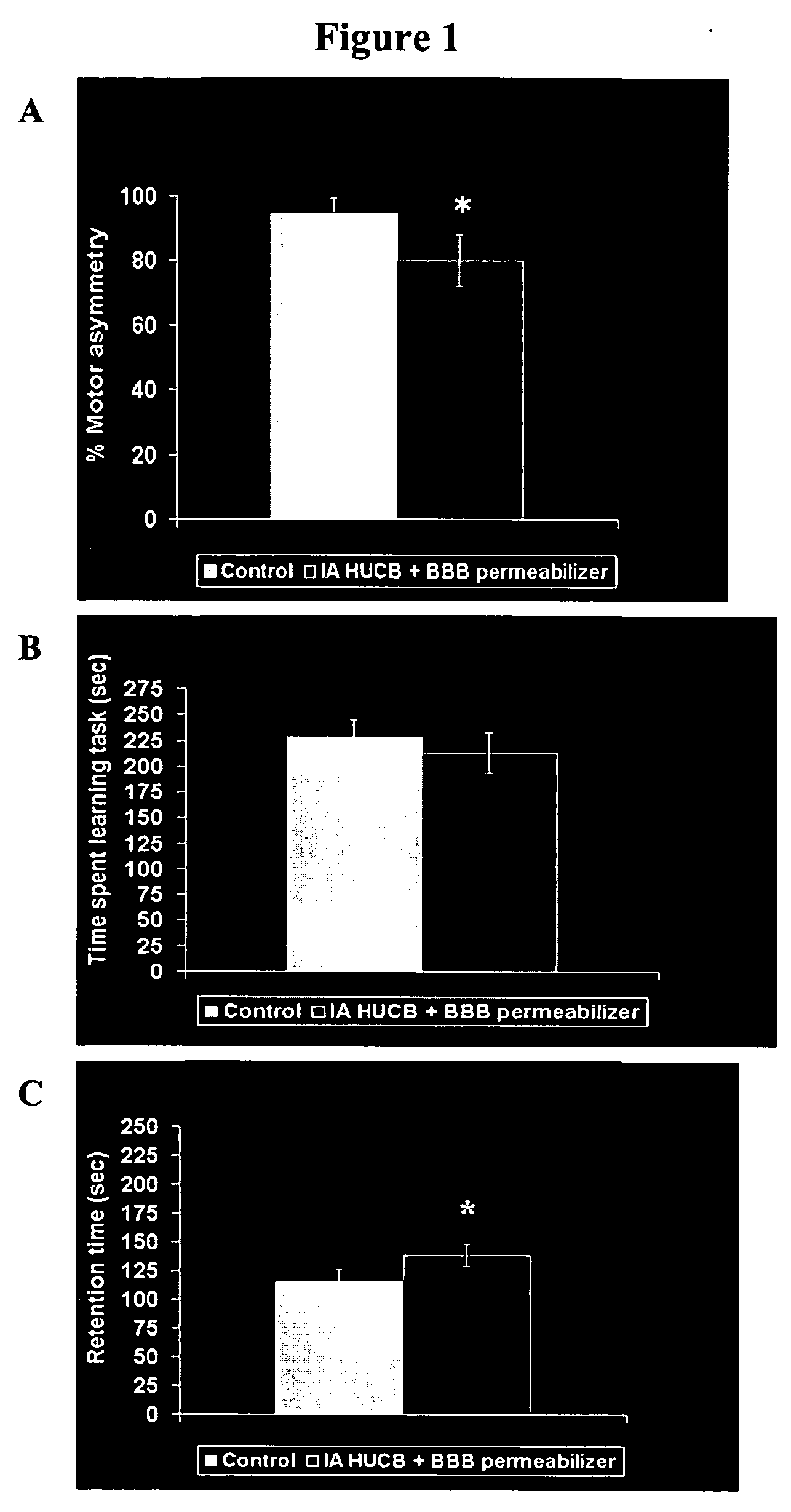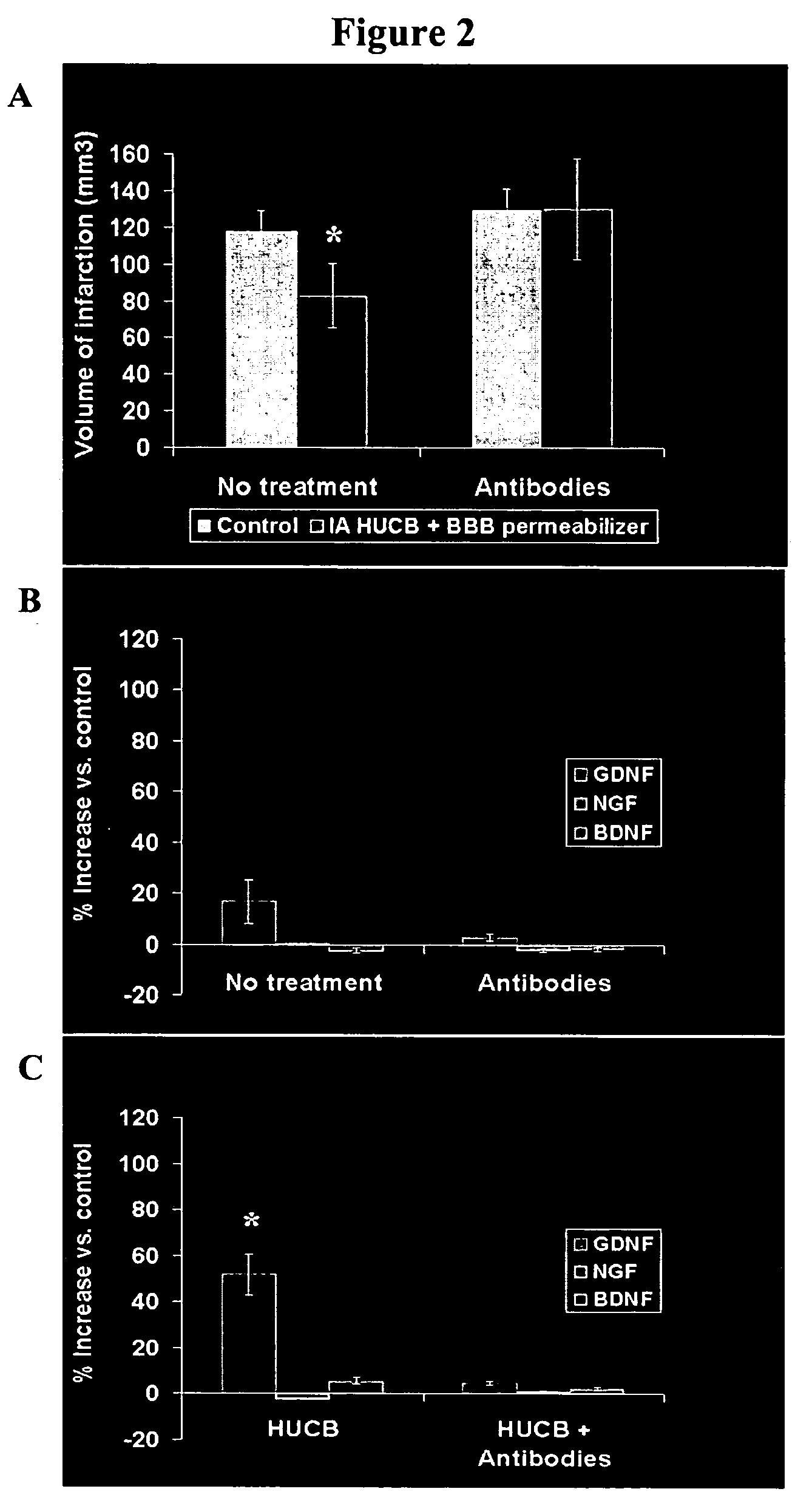Compositions and methods for enhancing neuroprotection via administration of stem cells and blood brain barrier permeabilizers
a technology of stem cells and blood brain barrier, applied in the direction of artificial cell constructs, biochemical apparatus and processes, biocide, etc., can solve the problems of ineffective treatment, insufficient data analysis for angioplasty, inability to change brain damage, etc., and achieve the effect of enhancing the neuroprotective effect of stem cell treatmen
- Summary
- Abstract
- Description
- Claims
- Application Information
AI Technical Summary
Benefits of technology
Problems solved by technology
Method used
Image
Examples
example 1
Permeabilization of the blood brain barrier with mannitol enhances the behavioral effects of HUCB transplantation
[0092] The histological and neurobehavioral effects of early intracerebral and intra-arterial delivery of HUCB cells into rats during transient middle cerebral artery (MCA) occlusion were examined (Lobel et al., 2003 Exper. Neurol. 181: 97-98). Twenty-six adult male Sprague-Dawley rats were subjected to right MCA occlusion for 60 minutes. During the one-hour occlusion, animals were subjected to intra-arterial (IA) injection of HUCB (200,000 cells in 10 ul), with or without a blood brain barrier permeabilizer (1.1 M mannitol at 4° C.). Behavioral tests were conducted on post-stroke day 3, prior to sacrificing animals for histology to determine lesion volumes and HUCB cell survival. Separate sets of identically treated animals were used to measure brain levels of glial cell line-derived neurotrophic factor (GDNF), nerve growth factor (NGF), and brain-derived neurotrophic ...
example 2
Permeabilization of the blood brain barrier with mannitol significantly reduces infarct volume following stroke
[0105] Animals were treated as described in Example 1.
[0106] Quantification of HUCB cell graft survival: 20 μm cryostat sectioned tissues were examined at 4× magnification and digitized using a PC-based Image Tools computer program. For estimation of surviving transplanted HUCB cells, sections were blind-coded and Abercrombie's formula was used to calculate the total number of NCAM-positive cells. Double-labeling of these human-specific antibodies with GFP provides unequivocal identification of HUCB cell grafts. Alternate brain sections were processed using antibodies directed against human neurons (NeuN), glia (GFAP), and oligodendrocytes (0-1) to reveal phenotypic differentiation of HUCB. Additional alternate brain sections were processed for Hematoxylin and Eosin to reveal the extent of cerebral damage. Cell counts were conducted to reveal the number of surviving HUCB...
example 3
Permeabilization of the blood brain barrier with mannitol significantly increases neurotrophic activity
[0108] The decrease in lesion volume 3 days after MCAo suggests that the HUCB cells are either exerting a direct trophic effect on the damaged tissue or are elevating endogenous levels of trophic activity. Replicating the above data, separate studies again confirmed that combining HUCB cells with mannitol produced a significant neuroprotective effect (FIGS. 3A-C). These studies also revealed associated elevations of brain levels of GDNF (increased 68% above controls, data not shown).
[0109] To confirm the potential involvement of trophic factors in the observed neuroprotection, one set of animals received MCAo plus HUCB and mannitol (n=12), while a second group of animals (n=20) were treated identically except that the HUCB cells were exposed to antibodies against NGF, GDNF and BDNF prior to transplantation. As anticipated, the elevations in GDNF levels were prevented (FIGS. 2B a...
PUM
| Property | Measurement | Unit |
|---|---|---|
| Fraction | aaaaa | aaaaa |
| Fraction | aaaaa | aaaaa |
| Time | aaaaa | aaaaa |
Abstract
Description
Claims
Application Information
 Login to View More
Login to View More - R&D
- Intellectual Property
- Life Sciences
- Materials
- Tech Scout
- Unparalleled Data Quality
- Higher Quality Content
- 60% Fewer Hallucinations
Browse by: Latest US Patents, China's latest patents, Technical Efficacy Thesaurus, Application Domain, Technology Topic, Popular Technical Reports.
© 2025 PatSnap. All rights reserved.Legal|Privacy policy|Modern Slavery Act Transparency Statement|Sitemap|About US| Contact US: help@patsnap.com



